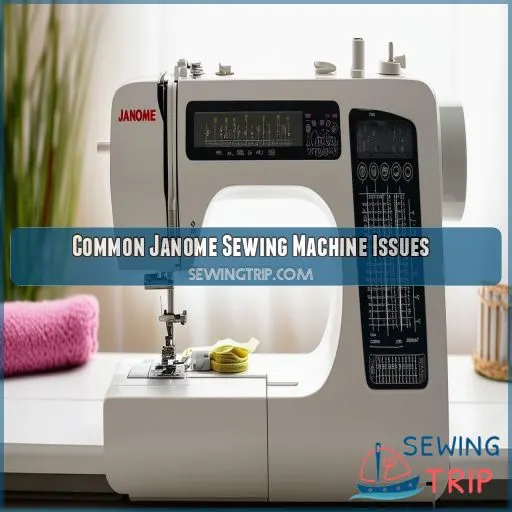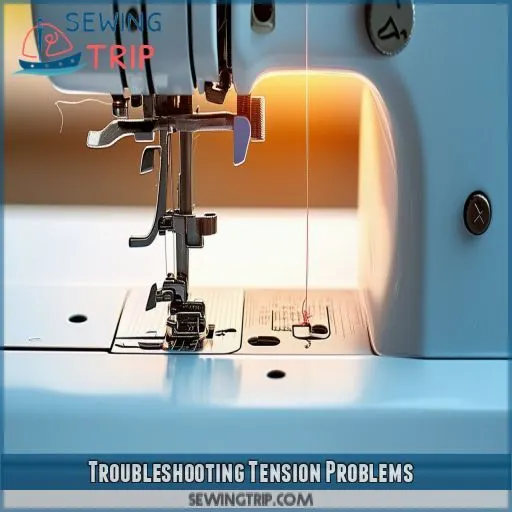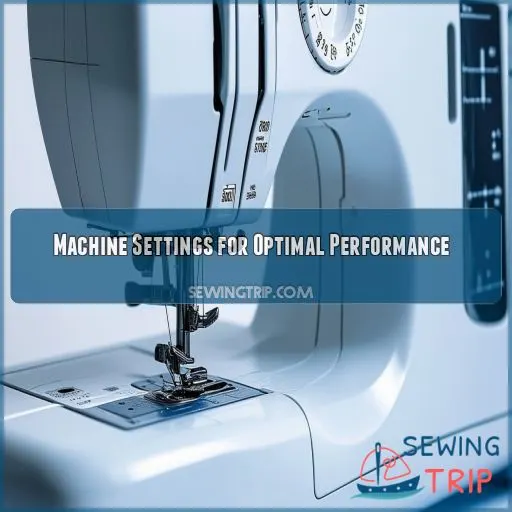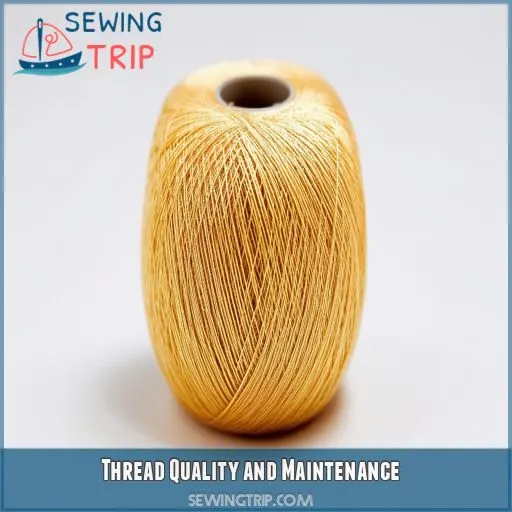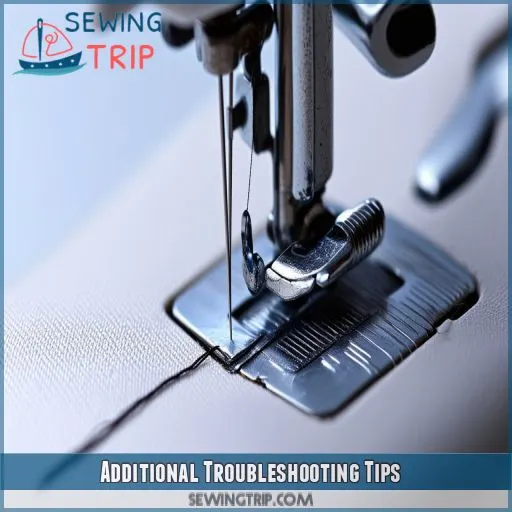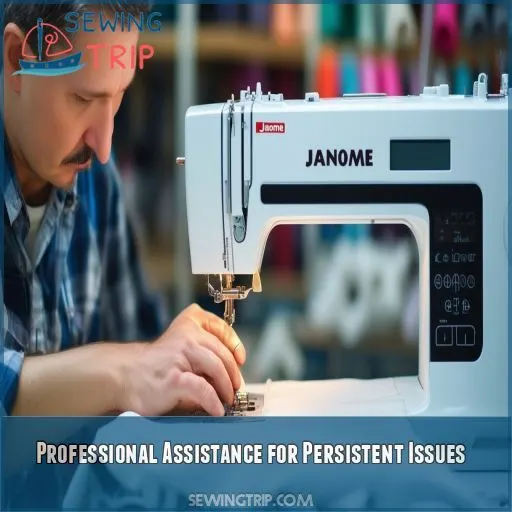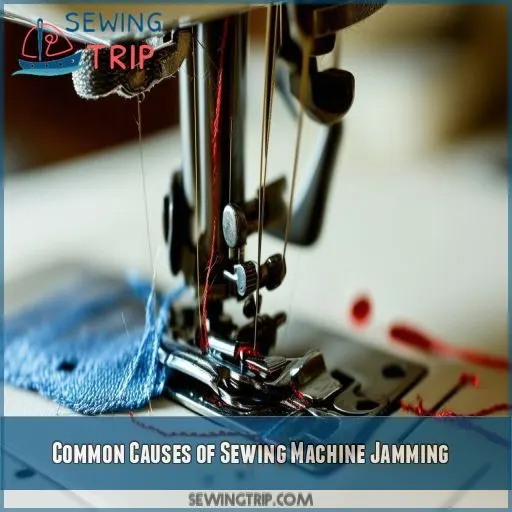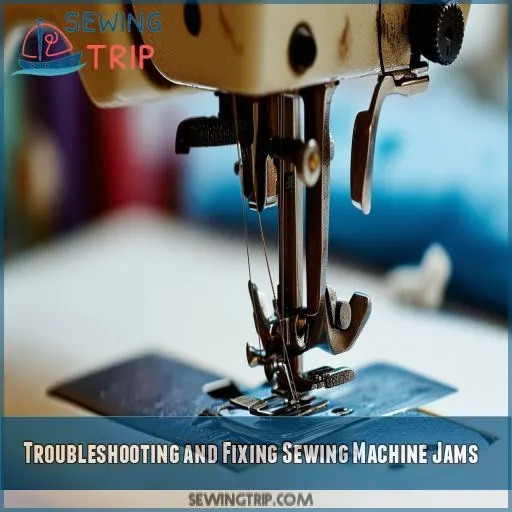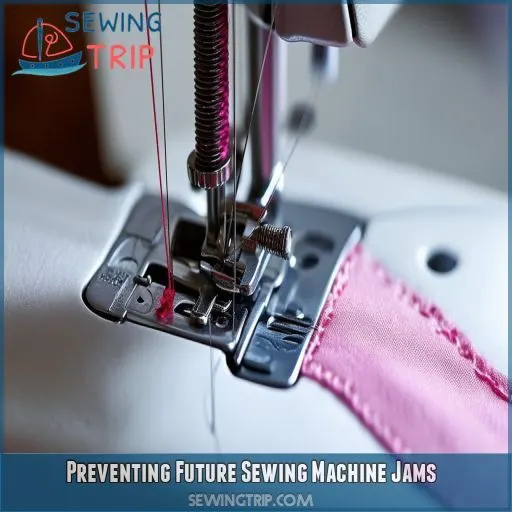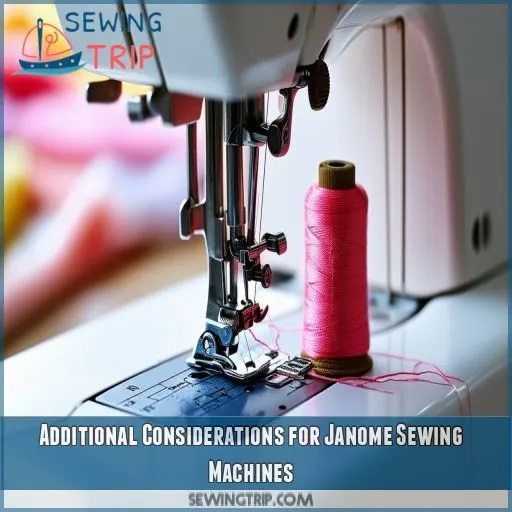This site is supported by our readers. We may earn a commission, at no cost to you, if you purchase through links.
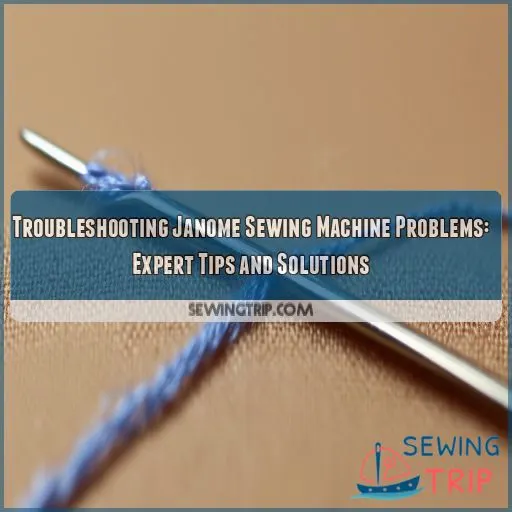
Learn how to solve such common Janome problems as the misbehaving bobbin thread, tension issues, and machine jamming.
Find out how to maintain such machines by offering them proper tips and when you need a service provider.
Find popular troubleshooting tips to get your [FOCUS KEYWORD] sewing back on track
Table Of Contents
- Key Takeaways
- Common Janome Sewing Machine Issues
- Troubleshooting Tension Problems
- Machine Settings for Optimal Performance
- Thread Quality and Maintenance
- Additional Troubleshooting Tips
- Professional Assistance for Persistent Issues
- Common Causes of Sewing Machine Jamming
- Troubleshooting and Fixing Sewing Machine Jams
- Preventing Future Sewing Machine Jams
- Additional Considerations for Janome Sewing Machines
- Frequently Asked Questions (FAQs)
- Conclusion
Key Takeaways
- Next time your bobbin acts up, don’t be a needle in a haystack – check for lint, proper winding, and tension!
- When your machine throws a stitch fit, don’t lose your thread – inspect the feed dogs and bobbin area for lint and debris.
- If your tension’s out of whack, don’t get in a twist – try cleaning, adjusting, and rethreading to find the sweet spot.
- Jams got you down? Don’t be a knothead – stop, assess, remove fabric and thread, and give your machine some TLC
Common Janome Sewing Machine Issues
You might face issues with your Janome sewing machine such as bobbin thread not picking up or improper bobbin tension. Identifying problems like poorly wound bobbins, lint in the bobbin area, or a damaged needle or needle plate can help you keep your machine running smoothly
Bobbin Thread Not Picking Up
When your bobbin thread isn’t picking up, try:
- Checking the bobbin assembly.
- Making tension adjustments.
- Ensuring material compatibility.
- Verifying proper thread spooling and needle lubrication.
These steps help avoid jams
Incorrect Bobbin Placement
Unless, of course, the bobbin is placed upside down—then it can wreak havoc with your stitching. Make sure the bobbin is inserted correctly by checking on the bobbin case orientation, alignment, and latching. Another common mistake using bobbins is misaligned ones, causing thread misplacement or incorrect tension.
Improper Bobbin Tension
Incorrect tension in the bobbin may result in uneven stitches and/or thread nesting. Ensure consistent tension by:
- Bobbin placement done right.
- Bobbin case type check.
- Test by different bobbin qualities.
- The proper winding of the bobbin
Poorly Wound Bobbin
Ensure the correct bobbin is wound using the right bobbin type and case. Check for lint or fibers in the bobbin area that may affect tension. Proper bobbin winding is critical to smooth sewing.
Lint or Debris in Bobbin Area
When dealing with sewing mishaps, don’t overlook the bobbin area. Lint and debris can wreak havoc, so prioritize:
- Regular bobbin area cleaning
- Effective lint removal techniques
- Debris prevention strategies
- Frequent bobbin case inspections
- Maintenance best practices
Damaged Needle or Needle Plate
Damage to needles or the needle plate causes sewing machine issues. Regularly inspect and replace dull or bent needles for smooth operation.
| Issue | Cause |
|---|---|
| Needle damage | Improper insertion |
| Bent needles | Hitting needle plate |
| Dull needles | Extended use |
| Needle plate | Poor fabric choice |
Troubleshooting Tension Problems
Solve your Janome sewing machine’s tension issues by cleaning the bobbin area and feed dogs, using manufacturer bobbins and needles, referring to the thread and needle chart, and rethreading the machine from top to bottom—refer to your user manual for exact directions
Refer to User Manual
When facing tension issues with your Janome machine, your first step should be to refer to the user manual. This troubleshooting guide provides beginner tips, advanced techniques, and maintenance advice, helping you solve most common problems efficiently
Clean Bobbin Area and Feed Dogs
Clean the bobbin area and feed the dogs. Make sure that the lint or another form of debris doesn’t interfere with the performance; regular cleaning will help maintain a consistent tension.
- Use a lint brush
- Vacuum attachments help
- Take off bobbin case
• Check under feed dogs
Use Brand Bobbins and Needles
Only the brand name of the bobbin and needle will guarantee the creation of problem-free fabrics. Other types of bobbins or non-brand versions will create tension problems in your work. The device will run smoothly while sewing if the bobbins are correctly set and the well-seated bobbin cases are cleaned regularly for the perfect functioning of your Janome.
Check Thread and Needle Chart
Ensure you’re using the right needle and thread by referring to the thread and needle chart. Proper needle selection and thread compatibility verify that there won’t be any tension problems, which also reduces user error. Check the chart’s accuracy regularly for continued optimum performance of machine and component life.
Rethread Machine Top and Bottom
Rethread the machine from top to bottom to correct threading problems. Consider the threading angles, top thread tension, and bottom thread problems critically. Accurate rethreading of the machine avoids stitching errors and increases overall performance.
Machine Settings for Optimal Performance
For perfect performance of the sewing machine while working, consider the correct embroidery settings and a sharp needle. Clean the needle plate regularly, then adjust the top tension to 3 and the bobbin tension to auto for smooth sewing.
Verify Correct Embroidery Settings
Check your Janome machine’s embroidery settings in order to prevent issues:
- Make sure all settings are in place for your embroidery project.
- Ensure that the top tension is 3.
- Verify the auto setting is confirmed for tension on the bobbin
Check Needle for Bending or Dullness
Check frequently for bent or dull needles. Use the correct type and size of needles appropriate to your type of fabric and inserted correctly so they don’t skip or break. Caring for needles will most likely involve frequently changing them to keep your sewing machine at its best.
Clean Needle Plate
Now inspect your needle plate for damage, burrs on the needle hole, or too much accumulation of lint. If it scratches other fabrics or generally aligns poorly, clean it thoroughly and check for misalignment. Make sure it’s smooth to avoid other problems.
Adjust Top Tension to 3
Set the top tension dial to 3 for the best sewing performance. This allows to achieve quality balanced stitches. Here’s how:
- Find the tension dial.
- Turn to setting number 3.
- Check if the stitches are smooth.
- Modify as needed
Set Bobbin Tension to Auto
First, set the bobbin tension to auto. You’ll get a continuous stitch. You might find what you want. Be prepared to override the system as necessary manually. Make sure you have bobbins compatible with your Janome and adjust accordingly, using expert advice for optimum performance on your machine.
Thread Quality and Maintenance
For top machine operation, always use superior embroidery thread and frequently check the bobbin yarn for tangles or snags. Properly clean and lubricate your machine, change the needle often, and use the correct bobbin case for embroidery.
Use High-Quality Embroidery Thread
This can be avoided by using good embroidery thread. With the right thread types, the proper tension is relatively easy. This ensures fluent stitching without breaks. The threads should be kept well and checked to ensure it will blend with your bobbin thread for perfect performance.
Check Bobbin Thread for Tangles or Loose Threads
Follow these steps to ensure quality threads and refrain from all loose threads and bobbin tangles:
- Check the bobbin case for accumulation of lint.
- Ensure that the bobbin is adequately filled and inserted.
- Replace bobbins and threads on time
Clean and Lubricate Machine Regularly
Regular cleaning and lubrication is essential. Use appropriate cleaning and lubricating supplies, and make sure that you use methods that will ensure the machine can be used over a long period. Clean frequently to avoid lint buildup; this can cause problems. Proper lubrication ensures minimal friction, allowing the system to move quickly, hence machine life is longer.
Replace Needle Regularly
Always change the needle regularly for the best sewing performance. Every so often, check the point, size, and type of the needle, and more than likely, you’ll want to look at the kind of fabric and thread being used. Proper needle storage helps to keep it from becoming damaged between uses.
Use Appropriate Bobbin Case for Embroidery
Applying the proper bobbin case to an embroidery machine intensifies its performance: it gives proper tension with minimal mistakes.
- Select the adequate type of bobbin case.
- Use high quality embroidery floss.
- Regular cleaning of the bobbin case.
-> Make sure the seating of the bobbin case is proper.
- Replace whenever necessary
Additional Troubleshooting Tips
Always lift the presser foot to troubleshoot your Janome sewing machine, allowing for threading and tensioning the thread. Check that the thread is firmly seated within the take-up lever and drawn between the notches within the bobbin case to help prevent skipped stitches and jamming.
Raise Presser Foot Before Threading
The presser foot must be lifted before threading to raise the tension discs. The maximum functionality can be guaranteed through properly positioned feet, the correct type of thread and tension, interaction with the correct needle size, and presser foot pressure.
Ensure Thread is Seated in Take-Up Lever
Make sure the thread is inserted properly into the take-up lever to prevent sewing problems. Be sure to:
- Lift the presser foot
Guide the thread through the lever slot.
Check for snags or tangles.
- Confirm proper threading path
Avoid Missing Top Thread Guides
This will help avoid missing the top thread guides, hence making the thread follow the correct path. Any missing guides will affect the path variations of the thread and thus its tension quality, which may eventually lead to breakage. This helps in forming stitches and therefore achieves smoother sewing.
Check Bobbin Thread Direction
Make sure the bobbin thread is wound correctly and the bobbin is inserted with the correct thread direction. Incorrect placement can cause thread jams and uneven stitching. Follow these steps:
- Check the winding direction.
- Insert bobbin properly.
- Confirm thread flows smoothly.
- Recheck and adjust if needed
Draw Thread Through Bobbin Case Notches
Do remember to pass the thread through the notches in the bobbin case. Misalignment or even accumulation of lint may cause problems with its performance. An adequately seated bobbin case will click properly to place for smooth performance.
| Check | Solution |
|---|---|
| Placement | Proper seating |
| Tension | Adjust if needed |
| Lint | Regularly clean |
| Type | Use correct case |
Professional Assistance for Persistent Issues
If problems persist, contact an authorized dealer as your machine may need a thorough evaluation. Local dealers, like Northern Threads and J & H Sewing & Vacuum Inc., can help determine the cause of the tension issues and provide expert assistance
Contact Authorized Dealer if Issues Persist
If your Janome machine still acts up after troubleshooting, it may be time for professional assistance. Reaching out to an authorized dealer ensures expert help.
- Get in touch with local suppliers like Northern Threads.
- Consult J & H Sewing & Vacuum Inc.
- They can determine underlying problems efficiently
Machine May Require Examination
Your machine may require a professional evaluation if issues persist. An authorized dealer can perform a thorough machine evaluation and provide a repair estimate. Diagnostic steps will uncover potential causes of the problem. Check if your warranty coverage includes such evaluations and repairs, saving you costs
Determine Cause of Tension Problems
To determine the cause of tension problems, you’ll need to:
- Check bobbin placement, ensuring the bobbin case is seated correctly.
- Verify that you’re using the correct bobbin type for your machine.
- Rethread the machine, making sure the bobbin thread direction is accurate
Local Dealers: Northern Threads, J & H Sewing & Vacuum Inc
If tension problems persist, visit local authorized dealers for repair. Northern Threads and J & H Sewing & Vacuum Inc. offer expert machine maintenance and repair. They can diagnose underlying issues quickly, ensuring your Janome machine operates flawlessly.
| Dealer | Services |
|---|---|
| Northern Threads | Repairs, Maintenance, Sales |
| J & H Sewing & Vacuum Inc. | Troubleshooting tips, Authorized repair |
| Local dealers | Routine checks, Part replacements |
Common Causes of Sewing Machine Jamming
Sewing machine jams often stem from incorrect thread tension, thread misplacement, or bobbin issues. Additionally, dull or bent needles and fabric-needle mismatches can cause significant disruptions
Incorrect Thread Tension
Improper tension will cause threads jamming and lead the way for uneven stitches. Ensure proper bobbin tension, verify no damaged needle, and ensure correct techniques for winding bobbins. The regular adjustment of tension can prevent most of the common problems in the Janome machine.
Thread Misplacement
Threading problems can cause skipped stitches, pulling of fabric, and even breaking a needle. Ensure the thread is in the correct path and seat it properly to avoid problems with tension. This guarantees that the Janome sewing machine will run at high performance with every seam.
Bobbin Issues
Bobbin problems can lead to jamming of the sewing machine. Inspect your bobbin for misalignment, loose threading, or incorrect installation. Make sure that your:
The bobbin winder is functioning
- Bobbin thread has no tangles
- Bobbin case is clear
- Bobbin is properly in place
Dull or Bent Needles
If the needle is dull or bent, it could mean there’s a jam in the machine. Regularly inspect for damage and change the broken needles so you can sew smoothly. Use the correct type and size, and also check that it’s properly inserted to avoid problems.
| Needle Issue | Possible Problems | Solutions |
|---|---|---|
| Dull Needle | Skipped Stitches | Replace Needle |
| Bent Needle | Needle Jams | Replace Needle |
| Using the wrong needle type | Fabric damage | Use appropriate needle |
| Missing insertion | Poor stitch quality | Successful insertion |
| Infrequent Changes | Thread Breakage | Regular Replacement |
Fabric and Needle Mismatch
The wrong kind of needle on your fabric may result in jams. Use needles appropriate for the types of fabric one has while sewing. Adjust tensions, use good thread quality, and check the weaving of the bobbin to sew comfortably without any problems.
Troubleshooting and Fixing Sewing Machine Jams
First, stop and carefully assess the situation to identify the cause of the sewing machine jam. Then, remove the fabric and thread to reset the machine, ensuring the jammed area is clear
Stop and Assess
Stop, and with your sewing machine, stop the problem when it jams. Here’s how:
- Examine bobbin assembly: Check for alignment and fit.
- Identify the thread path: See to it that the thread is drawn properly.
- Tension dial test: Check tension dial.
- Needle selection: Ensure correct and damage-free needles are used.
- Routines for care and maintenance: Cleaning and oiling of the machine at specified regular intervals
Remove Fabric and Thread
First, turn your machine off and remove the material and thread. Very carefully lift the presser foot and then pull the material directly out of the machine toward you.
Pay special attention to broken needle pieces or loose thread so you don’t create a problem. Cut away any thread breakage, and clean out all lint from the bobbin case. This will eliminate the hindrances and ensure that sewing will be smooth
When Should You Seek Professional Help?
If you’ve tried all the previous steps and still encounter problems, it’s time to seek professional assistance. Here are signs you need expert help:
- Machine isn’t responding.
- Persistent tension issues.
- Unusual noises or vibrations.
- Complex error codes.
- Repeated jamming.
Contact local dealers like Northern Threads or J & H Sewing & Vacuum Inc., or Janome support for machine repair
Preventing Future Sewing Machine Jams
Consider the following: maintain proper sewing practices and follow the regular maintenance program to prevent more jams from occurring in the future. By doing this, your machine will remain clean and well-lubricated, run smoothly, and serve you for many more years.
Best Practices for Proper Sewing
To avoid future sewing machine jams, focus on fabric selection, needle lubrication, presser foot pressure, tension adjustments, and proper thread winding. Ensuring smooth, frustration-free sewing involves some essential habits. Always use the correct needle for your fabric, and keep it well-lubricated. Adjust presser foot pressure and thread tension to match your fabric’s thickness. Properly wind your thread for consistent stitching. Follow these practices for smoother operation and fewer interruptions.
| Issue | Cause | Solution |
|---|---|---|
| Fabric Sticking | Wrong Needle | Use Suitable Needle |
| Skipped Stitches | Poor Lubrication | Lubricate Needle Regularly |
| Tension Problems | Incorrect Settings | Adjust Tension, Presser Foot |
| Thread Breaking | Improper Winding | Wind Thread Properly |
| Fabric Jamming | Wrong Presser Foot | Adjust Presser Foot Pressure |
Regular Maintenance Schedule
To prevent future sewing machine jams, follow a regular maintenance schedule. Clean your Janome machine regularly—dust the bobbin area, feed dogs, and needle plate.
Lubricate according to the manual’s lubrication frequency recommendations. This keeps all moving parts well-oiled and functioning smoothly. Stick to a cleaning schedule, and don’t forget about checking the warranty coverage for free or discounted repairs
Additional Considerations for Janome Sewing Machines
For stubborn issues, check for lashing on the bottom of designs and adjust bobbin tension manually if needed. If problems persist, try a different bobbin case, contact Janome customer support, or consult a professional technician
Check for Lashing on Bottom of Designs
Examine designs for lashing on the underside; this can indicate tensions being out. Always ensure the bobbin area is free of stray threads and lint. Bobbin placement — Sometimes, you may need to rethread your bobbin to address a consistently lashed angle.
Adjust Bobbin Tension Manually if Necessary
If the tension dial isn’t adjusted correctly, you may need to change the bobbin tension yourself. Use a small screwdriver and turn the screw on the case a little bit. Make sure you’re using the right color of thread.
Try Using a Different Bobbin Case
If bobbin tension problems persist, replace the bobbin case. Research all the other replacement bobbin cases available for your Janome machine to ensure the best performance and stitches are out there.
- Use a replacement bobbin case specifically designed for your Janome model.
- Compare the main features of different bobbin case models, including their product specifications.
- Gently put in the new bobbin case, ensuring it’s put in and clicked into place correctly.
- To verify the performance of the lines by the new bobbin case, test first before continuing to perform the rest of the project.
Contact Janome Customer Support for Further Assistance
If none of your efforts to rectify the problem has worked, don’t hesitate to call Janome customer support to take it from there. They’ll give you expert advice and, possibly, corrective measures you haven’t thought of yet to ensure your machine is in top shape.
Consult a Professional Sewing Machine Technician
If this occurs and the problem persists, then you have to seek advice from a sewing machine professional. They’ll check your sewing machine to be sure whether the bobbin case requires some maintenance, how frequently you need to replace the needles, some tip settings for the tension dial, bobbin winder issues, and the belt or gear wear and tear.
Frequently Asked Questions (FAQs)
How do I reset my Janome sewing machine?
To reset your Janome sewing machine, start by turning it off and unplugging it. Then, press and hold the reset button or follow the specific reset instructions in your user manual. Good luck!
What are the 10 common sewing machine troubles?
You may encounter these common sewing machine troubles: needle issues, improper threading, tension problems, lint buildup, incorrect bobbin placement, bobbin tension issues, poor stitch quality, faulty needle plate, loose parts, and damaged components
What is the most common problem when a machine doesn t sew correctly?
Proper threading is very important; the lack of it’s the most common issue that arises when your machine doesn’t work correctly. Always thread the machine properly, including top threading and bobbin, to prevent tension problems and skipping stitches.
Why does my sewing machine keep jamming underneath?
Bad threading, tangled bobbin thread, or lint accumulated in the bobbin section will cause your sewing machine to keep jamming from beneath. Properly thread, remove some of the lint, and then check the placement and tension of the bobbin for smooth working.
Why is my Janome sewing machine not working?
Examine your Janome sewing machine for improper threading, a misaligned bobbin, or a bent needle. Try cleaning out the lint and checking that you have the correct settings, and then re-thread both the top and bottom threads.
How do I know if my Janome Sewing Machine is good?
It’s been proven that 90% of all sewing machine problems are user error. Keep your Janome running smoothly by cleaning regularly, using good quality thread, and properly threading it per the manufacturer’s instructions.
How do you fix a Janome sewing machine not stitching correctly?
Try rethreading your Janome sewing machine, cleaning the bobbin area, inserting the needle correctly, checking for a correct tension setting, and ensuring that you’re using good-quality threads. Otherwise, have a workshop check be done with an authorized dealer for persistent failures.
Do Janome sewing machines have bobbin thread problems?
Imagine your Janome sewing smoothly, then encountering bobbin thread issues. Janome machines can face problems like incorrect bobbin placement, tension issues, lint buildup, or poorly wound bobbins. Regular maintenance and proper threading reduce these issues
How to change the presser foot?
To change the presser foot on a Janome machine, first raise the presser foot lever. Next, press the release button on the foot holder, replace the foot, then lower the presser foot lever to secure it
Tips for cleaning feed dogs?
To clean the feed dogs, first lower the presser foot and remove the needle plate. Use a brush to clear lint and debris, then reassemble. Ensuring clean feed dogs enhances fabric movement and stitching quality
How to adjust stitch length?
To adjust stitch length, locate your machine’s stitch length dial or digital control. Turn or set it to your desired length. Typically, a range from 0 to 5 millimeters is available, allowing for varied stitch sizes
What are presser foot pressure settings?
Pressure adjustment on a presser foot is very crucial to feeding fabric. Locate your pressure adjustment dial, commonly top or side-mounted on your machine. This ensures smooth, even stitches by turning clockwise to increase pressure and counterclockwise to decrease.
Guidelines for lubricating moving parts?
Visualize a well-oiled machine, smoothly operating without friction. Regularly lubricate its moving parts by using sewing machine oil, targeting the shuttle hook and bobbin area. Keep your performance seamless, efficient, and frustration-free
Conclusion
Get your Janome running like new again with the proper know-how. With this step-by-step troubleshooting guide to Janome’s sewing machine problems, you can handle common issues like mishaps with the bobbin, tension troubles, and simple machine jams.
Threading and maintenance done right, together with professional consultations where necessary, will extend the life of your sewing machine.
Proper respect and care, such as regular threading and consistent maintenance, along with consultation with professionals where necessary, will ensure your sewing machine has a longer life.
With these expert tips and solutions, you can better place your Janome to sew efficiently

